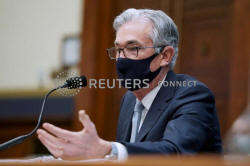Fed minutes may shed light on bond plans, views of vaccine
 Send a link to a friend
Send a link to a friend
 [January 06, 2021] By
Howard Schneider [January 06, 2021] By
Howard Schneider
WASHINGTON (Reuters) - The Federal
Reserve's decision in December to leave its monthly bond purchases
unchanged dismayed analysts and investors who thought the central bank
should have expanded the program to better support the economy through
the coronavirus pandemic.
The minutes of that meeting will be released Wednesday and are likely to
detail just what drove that decision and how the Fed is factoring the
promise of a coronavirus vaccine into its plans. Of greatest interest is
any insight those minutes offer into what it would take for central
bankers to shift monetary policy in coming months if widespread
immunization triggers a stronger economic rebound.
The minutes will be released at 2 p.m. (1900 GMT), and Fed officials in
recent days have already begun sketching out that next phase of their
debate - a discussion likely to hinge on how successful the country is
in delivering coronavirus shots to its 330 million residents.

"The faster we get that under control the more robust this recovery is
going to look,” Atlanta Federal Reserve President Raphael Bostic said in
an interview with Reuters this week. "We just have to ride out this
time, continue to follow public health recommendations and try to
minimize the spread," while the vaccine is distributed.
Bostic said he thought it possible that by late spring or summer,
businesses that have been kept off line and people that have been kept
inside because of the pandemic may resume "more normal types of
interaction ... the middle part of the year will be quite strong."
That, in turn, could allow the Fed to begin at least discussing how and
when to pull back on the $120 billion in monthly bond purchases it has
been making since last spring to keep financial markets functioning and
hold long-term interest rates at their historic lows.
The Fed in December said it would keep those purchases going "until
substantial further progress has been made" in returning the economy to
full employment and lifting inflation to the Fed's 2% goal. Bostic said
he felt that condition might be met "in short order" this year if the
vaccination rollout is successful.
The minutes are likely to give some sense of how the Fed broadly views
that goal.
In economic projections issued in December, for example, policymakers at
the median said they expected the unemployment rate to fall to 5% by the
end of 2021. That is still well above the 3.5% low reached in February,
but marks a major improvement from the 14.7% hit in April.
[to top of second column] |

Federal Reserve Board building on Constitution Avenue is pictured in
Washington, U.S., March 19, 2019. REUTERS/Leah Millis

Cleveland Federal Reserve President Loretta Mester, however, said even that was
unlikely to warrant any changes in the bond program this year.
"I'm happy with the way policy is calibrated right now...But again, it's really
going to depend on the economy," Mester said on Tuesday.
When the Fed met on Dec. 15 and 16, it was only days after the first coronavirus
vaccine had been approved. Since then a second immunization has been okayed, and
distribution of both has begun.
In addition, Congress approved a $900 billion program that included help for
unemployed workers and small businesses, something Fed officials urged through
the fall to help fill the income gap left by the coronavirus recession.
Still, it's not clear how fast the vaccine will allow a return to normal
commerce - especially given progress with actual inoculations has been slower
than expected - or whether that will lead the Fed to shift its asset purchases.
The decision on when to curb the program and how to announce it is
consequential: a misstep, even saying the wrong thing at the wrong time, could
lead interest rates to rise and consumers and businesses to curb borrowing and
spending.

The risk of that sort of market "tantrum" coming out of a pandemic year means
the Fed's bondbuying will remain on hold through the year, analysts at
Cornerstone Macro wrote this week.
"Progress against the pandemic, combined with pent-up demand, a very high
savings rate, and strong fiscal support should deliver a solid economic
performance this year," Cornerstone Macro analysts wrote this week. "Even
so...the Fed won’t be swayed away from its very dovish stance."
(Reporting by Howard Schneider; Editing by Dan Burns and Andrea Ricci)
[© 2021 Thomson Reuters. All rights
reserved.] Copyright 2021 Reuters. All rights reserved. This material may not be published,
broadcast, rewritten or redistributed.
Thompson Reuters is solely responsible for this content. |